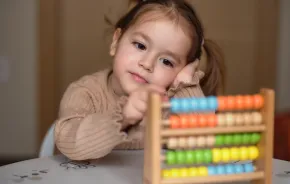
Photo:
Photo by Libby Lewis Photography
Editor's note: This article was sponsored by Epiphany School.
If your child has ever cried doing homework, the odds are good the subject was math. More than any other subject, math tends to be met with frustration, confusion and even fear. But math doesn’t have to be miserable. It’s normal for math to be hard, but making sure the struggle is healthy instead of horrible depends on developing a mathematical mindset.
The struggle is real
Math is a foundational skill for both the arts and the sciences. But mastering math concepts builds critical life skills, too.
“There is an element of perseverance and grit in mathematics, because answers don’t always come instantaneously. Growth happens when you struggle with something and work at it,” says Kelly Kursteiner, upper division math specialist at the independent Epiphany School in Seattle. Slowing down and working for an answer is more important than ever, because the digital age conditions us to expect instantaneous answers. But establishing a history of successful struggle is the recipe for building confidence.
“Mathematics is not a static thing that you learn and then are done with. It’s a way of growing and learning that is dynamic and interesting,” says Celia Russo, lower elementary division head at Epiphany School. Most parents of school-age children have heard of a growth mindset — the idea that effort is more important to success than natural ability. But adults who encourage their children to practice sports and spelling still tend to get stuck in the idea that some people are naturally good at math and the rest of us aren’t.
“It’s absolutely not true. Anyone can learn math,” Russo assures. The secret, she says, is to develop a mathematical mindset of open-minded curiosity and perseverance.
Algorithms are for search engines
Curiosity is as important as perseverance.
“The youngest students are ready and curious. We want to capture that moment for them,” says Russo. Too often, adults jump straight to the flash cards and algorithms. These things have their place, but too much rote learning becomes drudgery, and memorization should never come before comprehension.

“Sometimes teachers try to enter at too high a level,” explains Kursteiner. “They try to start with the abstract before the concrete, or even before asking what students already know and don’t know.” Struggle is not valuable when it’s too far past what students already understand. Some students can master algorithms right away. But knowing how to find the answer can shut down their curiosity about why the algorithm works, making it harder to grasp the underlying concepts.
Another way that adults can shut down natural curiosity is by passing on their own anxieties about math. Many of us have been guilty of saying things such as, “I’m not good at math, so I can’t help with this.” A better approach is to show curiosity and be willing to learn. “I didn’t learn that very well in school. Let’s see how much of it we can figure out together. How should we start?”
Mathematical mindset
Russo and Kursteiner both strongly recommend Jo Boaler’s book “Mathematical Mindset” for parents who want to learn more about this approach to teaching math. Building a mathematical mindset requires a safe space for learning. Teachers and parents need to reinforce the belief that mistakes are integral to learning.

“We refer to it as ‘wrong but brilliant,’ because wrong answers tell us something, too,” says Kursteiner. Mistakes can show us what we don’t understand yet. When you’re learning a concept, the process of figuring out how to get the answer is more important than the answer itself. When students themselves are too focused on getting the right answer, it can be helpful to start by giving it to them — then asking them to figure out how you got there. Adults can be as impatient to get the answer as students. But when frustrated adults rush kids towards a solution, they risk triggering a homework battle.
For kids who get stuck and lose confidence easily, try a technique called scaffolding. Ask questions to help the child get started, and then guide them through the steps slowly. When kids get stuck in “math panic,” it’s time to change directions. Try offering new ways of looking at the problem.
“Don’t think too much in terms of levels, because even very basic mathematical concepts can be very deep and complicated. It’s not backing up, it’s more about giving alternate pathways into a concept,” Russo explains.
Presenting concepts in a variety of ways helps different types of learners. Teachers will explain verbally, present visual illustrations and offer games that allow kinesthetic learners to move around. They give students opportunities to work alone, in pairs and in groups. Sometimes finding a pathway into a problem is about framing. Kursteiner gives the example of presenting subtraction in the form of addition: A student starts with 42 stickers and ends with 50. How many did they gain?
“All kids have some inherent understanding about math, but sometimes adults don’t validate or honor what they’re coming to us with. We want to start with something they’re not ready for and that makes kids shut down,” Kursteiner says. When, despite both your best efforts, you’re not getting anywhere, Kursteiner has advice that will help kids and adults breathe easier. Don’t finish the homework. Instead, stop and talk about how to ask the teacher for help at school tomorrow.
Teaching students how to advocate and ask questions, she says, is as important as the math itself. In time, students will not only learn how to ask for help from the teacher, they’ll start to recognize the tools that work best for them and use those strategies independently.
Playful math
Play is an important part of developing a mathematical mindset.
“There are so many different ways to solve math problems, so we want to give kids a lot of opportunities to just explore,” says Russo.
In Epiphany School classrooms, math play could look like open-ended exercises in which students find different numerical ways to describe dots drawn on the chalkboard or finding as many ways as possible to illustrate the concept of “five.” It could be card-sorting games for third-graders; fourth-graders exploring place value by building a wall out of blocks representing 10s and 100s; or fifth-graders playing with the concept of base numbers by using coins of different values to represent different counting systems.
From little kids playing with blocks and puzzles to older kids practicing fractions while cooking, Russo says, “Math tools are available all of the time.” Connecting math concepts to topics that kids are already interested in is a fun way to solve problems — and further evidence that having a mathematical mindset helps us understand the world.
|
Sponsored by: |

|











